A New Urban Built-Up Index and Its Application in National Central Cities of China
Abstract
1. Introduction
2. Materials and Methods
2.1. Study Areas
2.2. Data and Preprocessing
2.2.1. Nighttime Light Data
2.2.2. Normalized Difference Vegetation Index
2.2.3. Land Surface Temperature Data
2.2.4. Road Network Density Data
2.3. The VNRT
2.4. Validation of the VNRT Index
3. Results
3.1. Spatial Distribution
3.2. Transect Comparison in Typical Land Cover
3.2.1. Airport
3.2.2. City Park
3.2.3. Water
3.3. Urban Area Extracting Results
3.3.1. Local Threshold Method
3.3.2. Extracting Results from Local–Optimal Threshold Method
3.3.3. Accuracy Assessment
4. Discussion
5. Conclusions
Author Contributions
Funding
Data Availability Statement
Conflicts of Interest
References
- UN-Habitat. World Cities Report 2020; UN-Habitat: New York, NY, USA, 2020; Available online: https://unhabitat.org/sites/default/files/2020/10/wcr_2020_report.pdf (accessed on 2 October 2023).
- Ewing, R.; Rong, F. The Impact of Urban Form on US Residential Energy Use. Hous. Policy Debate 2008, 19, 1–30. [Google Scholar] [CrossRef]
- Foley, J.A.; DeFries, R.; Asner, G.P.; Barford, C.; Bonan, G.; Carpenter, S.R.; Chapin, F.S.; Coe, M.T.; Daily, G.C.; Gibbs, H.K.; et al. Global Consequences of Land Use. Science 2005, 309, 570–574. [Google Scholar] [CrossRef] [PubMed]
- Pataki, D.E.; Alig, R.J.; Fung, A.S.; Golubiewski, N.E.; Kennedy, C.A.; McPherson, E.G.; Nowak, D.J.; Pouyat, R.V.; Lankao, P.R. Urban Ecosystems and the North American Carbon Cycle. Glob. Change Biol. 2006, 12, 2092–2102. [Google Scholar] [CrossRef]
- Shukla, V.; Parikh, K. The Environmental Consequences of Urban-Growth—Cross-National Perspectives on Economic-Development, Air-Pollution, and City Size. Urban Geogr. 1992, 13, 422–449. [Google Scholar] [CrossRef]
- Xia, N.; Cheng, L.; Li, M. Mapping Urban Areas Using a Combination of Remote Sensing and Geolocation Data. Remote Sens. 2019, 11, 1470. [Google Scholar] [CrossRef]
- Hu, T.; Huang, X.; Li, D.; Jin, S.; Yan, Q. Comprehensive evaluation of the urban built-up areas mapping ability from Luojia 1-01 nighttime light imagery over China. Acta Geod. Cart. Sin. 2023, 52, 432–442. [Google Scholar]
- Yang, J. The Research on the Development Level Evaluation and Realization Path of Green Urbanization in China. Ph.D. Thesis, Northwest University, Kirkland, WA, USA, 2021. [Google Scholar] [CrossRef]
- Herold, M. Some Recommendations for Global Efforts in Urban Monitoring and Assessments from Remote Sensing. In Global Mapping of Human Settlement; Gamba, P., Herold, M., Eds.; Remote Sensing Applications Series; CRC Press: Boca Raton, FL, USA, 2009; Volume 20090662, ISBN 978-1-4200-8339-2. [Google Scholar]
- Ma, T.; Zhou, C.; Pei, T.; Haynie, S.; Fan, J. Quantitative Estimation of Urbanization Dynamics Using Time Series of DMSP/OLS Nighttime Light Data: A Comparative Case Study from China’s Cities. Remote Sens. Environ. 2012, 124, 99–107. [Google Scholar] [CrossRef]
- Liu, Y.; Yang, Y.; Jing, W.; Yao, L.; Yue, X.; Zhao, X. A New Urban Index for Expressing Inner-City Patterns Based on MODIS LST and EVI Regulated DMSP/OLS NTL. Remote Sens. 2017, 9, 777. [Google Scholar] [CrossRef]
- Zha, Y.; Gao, J.; Ni, S. Use of Normalized Difference Built-up Index in Automatically Mapping Urban Areas from TM Imagery. Int. J. Remote Sens. 2003, 24, 583–594. [Google Scholar] [CrossRef]
- Zha, Y.; Ni, S.; Yang, S. An Effective Approach to Automatically Extract Urban Land-use from TM Imagery. J. Remote Sens. 2003, 7, 37–40+82. [Google Scholar]
- Chen, X.-L.; Zhao, H.-M.; Li, P.-X.; Yin, Z.-Y. Remote Sensing Image-Based Analysis of the Relationship between Urban Heat Island and Land Use/Cover Changes. Remote Sens. Environ. 2006, 104, 133–146. [Google Scholar] [CrossRef]
- Xu, H. A New Index for Delineating Built-up Land Features in Satellite Imagery. Int. J. Remote Sens. 2008, 29, 4269–4276. [Google Scholar] [CrossRef]
- Xu, Z.; Gao, X. A novel method for identifying the boundary of urban built-up areas with POI data. Acta Geogr. Sin. 2016, 71, 928–939. [Google Scholar]
- Sutton, P.C.; Elvidge, C.; Obremski, T. Building and Evaluating Models to Estimate Ambient Population Density. Photogramm. Eng. Remote Sens. 2003, 69, 545–553. [Google Scholar] [CrossRef]
- Zhuo, L.; Ichinose, T.; Zheng, J.; Chen, J.; Shi, P.J.; Li, X. Modelling the Population Density of China at the Pixel Level Based on DMSP/OLS Non-Radiance-Calibrated Night-Time Light Images. Int. J. Remote Sens. 2009, 30, 1003–1018. [Google Scholar] [CrossRef]
- Cao, W.; Li, J.; Zhang, X. Research and Application of Rapid Extraction Method of Urban Built—Up Area by Using Night—Time Light Data: Taking Sichuan Province as an Example. Geomat. Spat. Inf. Technol. 2020, 43, 60–62+67. [Google Scholar]
- Zheng, Q.; Weng, Q.; Wang, K. Characterizing Urban Land Changes of 30 Global Megacities Using Nighttime Light Time Series Stacks. ISPRS J. Photogramm. Remote Sens. 2021, 173, 10–23. [Google Scholar] [CrossRef]
- Cao, X.; Hu, Y.; Zhu, X.; Shi, F.; Zhuo, L.; Chen, J. A Simple Self-Adjusting Model for Correcting the Blooming Effects in DMSP-OLS Nighttime Light Images. Remote Sens. Environ. 2019, 224, 401–411. [Google Scholar] [CrossRef]
- Li, X.; Xu, H.; Chen, X.; Li, C. Potential of NPP-VIIRS Nighttime Light Imagery for Modeling the Regional Economy of China. Remote Sens. 2013, 5, 3057–3081. [Google Scholar] [CrossRef]
- Shi, K.; Huang, C.; Yu, B.; Yin, B.; Huang, Y.; Wu, J. Evaluation of NPP-VIIRS Night-Time Light Composite Data for Extracting Built-up Urban Areas. Remote Sens. Lett. 2014, 5, 358–366. [Google Scholar] [CrossRef]
- Lu, D.; Tian, H.; Zhou, G.; Ge, H. Regional Mapping of Human Settlements in Southeastern China with Multisensor Remotely Sensed Data. Remote Sens. Environ. 2008, 112, 3668–3679. [Google Scholar] [CrossRef]
- Zhang, Q.; Schaaf, C.; Seto, K.C. The Vegetation Adjusted NTL Urban Index: A New Approach to Reduce Saturation and Increase Variation in Nighttime Luminosity. Remote Sens. Environ. 2013, 129, 32–41. [Google Scholar] [CrossRef]
- Zhao, L.; Lee, X.; Smith, R.B.; Oleson, K. Strong Contributions of Local Background Climate to Urban Heat Islands. Nature 2014, 511, 216–219. [Google Scholar] [CrossRef] [PubMed]
- Zhang, X.; Li, P. A Temperature and Vegetation Adjusted NTL Urban Index for Urban Area Mapping and Analysis. ISPRS-J. Photogramm. Remote Sens. 2018, 135, 93–111. [Google Scholar] [CrossRef]
- Gao, Z.; Hou, Y.; Chen, W. Enhanced Sensitivity of the Urban Heat Island Effect to Summer Temperatures Induced by Urban Expansion. Environ. Res. Lett. 2019, 14, 094005. [Google Scholar] [CrossRef]
- Peng, S.; Piao, S.; Ciais, P.; Friedlingstein, P.; Ottle, C.; Bréon, F.-M.; Nan, H.; Zhou, L.; Myneni, R.B. Surface Urban Heat Island across 419 Global Big Cities. Environ. Sci. Technol. 2012, 46, 696–703. [Google Scholar] [CrossRef] [PubMed]
- Han, W.; Tao, Z.; Li, Z.; Cheng, M.; Fan, H.; Cribb, M.; Wang, Q. Effect of Urban Built-Up Area Expansion on the Urban Heat Islands in Different Seasons in 34 Metropolitan Regions across China. Remote Sens. 2023, 15, 248. [Google Scholar] [CrossRef]
- Li, F.; Yan, Q.; Bian, Z.; Liu, B.; Wu, Z. A POI and LST Adjusted NTL Urban Index for Urban Built-Up Area Extraction. Sensors 2020, 20, 2918. [Google Scholar] [CrossRef]
- Hao, R.; Yu, D.; Sun, Y.; Cao, Q.; Liu, Y.; Liu, Y. Integrating Multiple Source Data to Enhance Variation and Weaken the Blooming Effect of DMSP-OLS Light. Remote Sens. 2015, 7, 1422–1440. [Google Scholar] [CrossRef]
- Chang, D.; Wang, Q.; Xie, J.; Yang, J.; Xu, W. Research on the Extraction Method of Urban Built-UP Areas with an Improved Night Light Index. IEEE Geosci. Remote Sens. Lett. 2022, 19, 1–5. [Google Scholar] [CrossRef]
- Zhou, Q. Comparative Study of Approaches to Delineating Built-Up Areas Using Road Network Data. Trans. GIS 2015, 19, 848–876. [Google Scholar] [CrossRef]
- Jia, T.; Jiang, B. Measuring Urban Sprawl Based on Massive Street Nodes and the Novel Concept of Natural Cities. arXiv 2010, arXiv:1010.0541. [Google Scholar]
- Borruso, G. Network Density and the Delimitation of Urban Areas. Trans. GIS 2003, 7, 177–191. [Google Scholar] [CrossRef]
- Zhou, Q.; Guo, L. Empirical Approach to Threshold Determination for the Delineation of Built-up Areas with Road Network Data. PLoS ONE 2018, 13, e0194806. [Google Scholar] [CrossRef] [PubMed]
- Strano, E.; Nicosia, V.; Latora, V.; Porta, S.; Barthélemy, M. Elementary Processes Governing the Evolution of Road Networks. Sci. Rep. 2012, 2, 296. [Google Scholar] [CrossRef] [PubMed]
- Zheng, Y.; Tang, L.; Wang, H. An Improved Approach for Monitoring Urban Built-up Areas by Combining NPP-VIIRS Nighttime Light, NDVI, NDWI, and NDBI. J. Clean. Prod. 2021, 328, 129488. [Google Scholar] [CrossRef]
- Zhao, M.; Zhou, Y.; Li, X.; Zhou, C.; Cheng, W.; Li, M.; Huang, K. Building a Series of Consistent Night-Time Light Data (1992–2018) in Southeast Asia by Integrating DMSP-OLS and NPP-VIIRS. IEEE Trans. Geosci. Remote Sens. 2020, 58, 1843–1856. [Google Scholar] [CrossRef]
- Elvidge, C.D.; Zhizhin, M.; Ghosh, T.; Hsu, F.-C.; Taneja, J. Annual Time Series of Global VIIRS Nighttime Lights Derived from Monthly Averages: 2012 to 2019. Remote Sens. 2021, 13, 922. [Google Scholar] [CrossRef]
- Wang, Z.; Chen, S. Development of the Remote Sensing Datasets of the Annual Nighttime Light in China from 1992 to 2021. Master’s, Thesis, Jilin University, Changchun, China, 2022. [Google Scholar] [CrossRef]
- Fensholt, R.; Rasmussen, K.; Nielsen, T.T.; Mbow, C. Evaluation of Earth Observation Based Long Term Vegetation Trends—Intercomparing NDVI Time Series Trend Analysis Consistency of Sahel from AVHRR GIMMS, Terra MODIS and SPOT VGT Data. Remote Sens. Environ. 2009, 113, 1886–1898. [Google Scholar] [CrossRef]
- Ren, T.; Zhou, W.; Wang, J. Beyond Intensity of Urban Heat Island Effect: A Continental Scale Analysis on Land Surface Temperature in Major Chinese Cities. Sci. Total Environ. 2021, 791, 148334. [Google Scholar] [CrossRef]
- Moradi, M.; Roche, S.; Mostafavi, M.A. Exploring Five Indicators for the Quality of OpenStreetMap Road Networks: A Case Study of Québec, Canada. Geomatica 2021, 75, 178–208. [Google Scholar] [CrossRef]
- Li, J.; Song, C.; Cao, L.; Zhu, F.; Meng, X.; Wu, J. Impacts of Landscape Structure on Surface Urban Heat Islands: A Case Study of Shanghai, China. Remote Sens. Environ. 2011, 115, 3249–3263. [Google Scholar] [CrossRef]
- Zheng, Y.; Zhou, Q.; He, Y.; Wang, C.; Wang, X.; Wang, H.; Ghosh, T. An Optimized Approach for Extracting Urban Land Based on Log-Transformed DMSP-OLS Nighttime Light, NDVI, and NDWI. Remote Sens. 2021, 13, 766. [Google Scholar] [CrossRef]
- Zhao, M.; Cheng, C.; Zhou, Y.; Li, X.; Shen, S.; Song, C. A Global Dataset of Annual Urban Extents (1992–2020) from Harmonized Nighttime Lights. Earth Syst. Sci. Data 2022, 14, 517–534. [Google Scholar] [CrossRef]
- Henderson, M.; Yeh, E.T.; Gong, P.; Elvidge, C.; Baugh, K. Validation of Urban Boundaries Derived from Global Night-Time Satellite Imagery. Int. J. Remote Sens. 2003, 24, 595–609. [Google Scholar] [CrossRef]
- Chen, Z.; Yu, B.; Song, W.; Liu, H.; Wu, Q.; Shi, K.; Wu, J. A New Approach for Detecting Urban Centers and Their Spatial Structure with Nighttime Light Remote Sensing. IEEE Trans. Geosci. Remote Sens. 2017, 55, 6305–6319. [Google Scholar] [CrossRef]
- Kii, M.; Tamaki, T.; Suzuki, T.; Nonomura, A. Estimating Urban Spatial Structure Based on Remote Sensing Data. Sci. Rep. 2023, 13, 8804. [Google Scholar] [CrossRef]
- Liu, X.; Hu, G.; Ai, B.; Li, X.; Shi, Q. A Normalized Urban Areas Composite Index (NUACI) Based on Combination of DMSP-OLS and MODIS for Mapping Impervious Surface Area. Remote Sens. 2015, 7, 17168–17189. [Google Scholar] [CrossRef]
- Li, F.; Liu, X.; Liao, S.; Jia, P. The Modified Normalized Urban Area Composite Index: A Satelliate-Derived High-Resolution Index for Extracting Urban Areas. Remote Sens. 2021, 13, 2350. [Google Scholar] [CrossRef]
- آذین نوروزی; الدوز نوروزی کاربرد الگوریتم پنجرة مجزا در شناسایی جزایر حرارتی شهرستان یزد: Application of Split-Window Algorithm to Study Urban Heat Island in Yazd County. Water Soil Manag. Model. Mudil Sazī Va Mudīriyyat-I Āb Va Khāk 2023, 3, 115–129. [CrossRef]
- Wang, M.; Song, Y.; Wang, F.; Meng, Z. Boundary Extraction of Urban Built-Up Area Based on Luminance Value Correction of NTL Image. IEEE J. Sel. Top. Appl. Earth Obs. Remote Sens. 2021, 14, 7466–7477. [Google Scholar] [CrossRef]
- Zhou, B.; Rybski, D.; Kropp, J.P. The Role of City Size and Urban Form in the Surface Urban Heat Island. Sci. Rep. 2017, 7, 4791. [Google Scholar] [CrossRef] [PubMed]
- Oke, T.R. City Size and the Urban Heat Island. Atmos. Environ. 1973, 7, 769–779. [Google Scholar] [CrossRef]
- Peng, J.; Liu, Q.; Xu, Z.; Lyu, D.; Du, Y.; Qiao, R.; Wu, J. How to Effectively Mitigate Urban Heat Island Effect? A Perspective of Waterbody Patch Size Threshold. Landsc. Urban Plan. 2020, 202, 103873. [Google Scholar] [CrossRef]
- Chen, H.; Jeanne Huang, J.; Li, H.; Wei, Y.; Zhu, X. Revealing the Response of Urban Heat Island Effect to Water Body Evaporation from Main Urban and Suburb Areas. J. Hydrol. 2023, 623, 129687. [Google Scholar] [CrossRef]
- Ghosh, S.; Das, A. Modelling Urban Cooling Island Impact of Green Space and Water Bodies on Surface Urban Heat Island in a Continuously Developing Urban Area. Model. Earth Syst. Environ. 2018, 4, 501–515. [Google Scholar] [CrossRef]
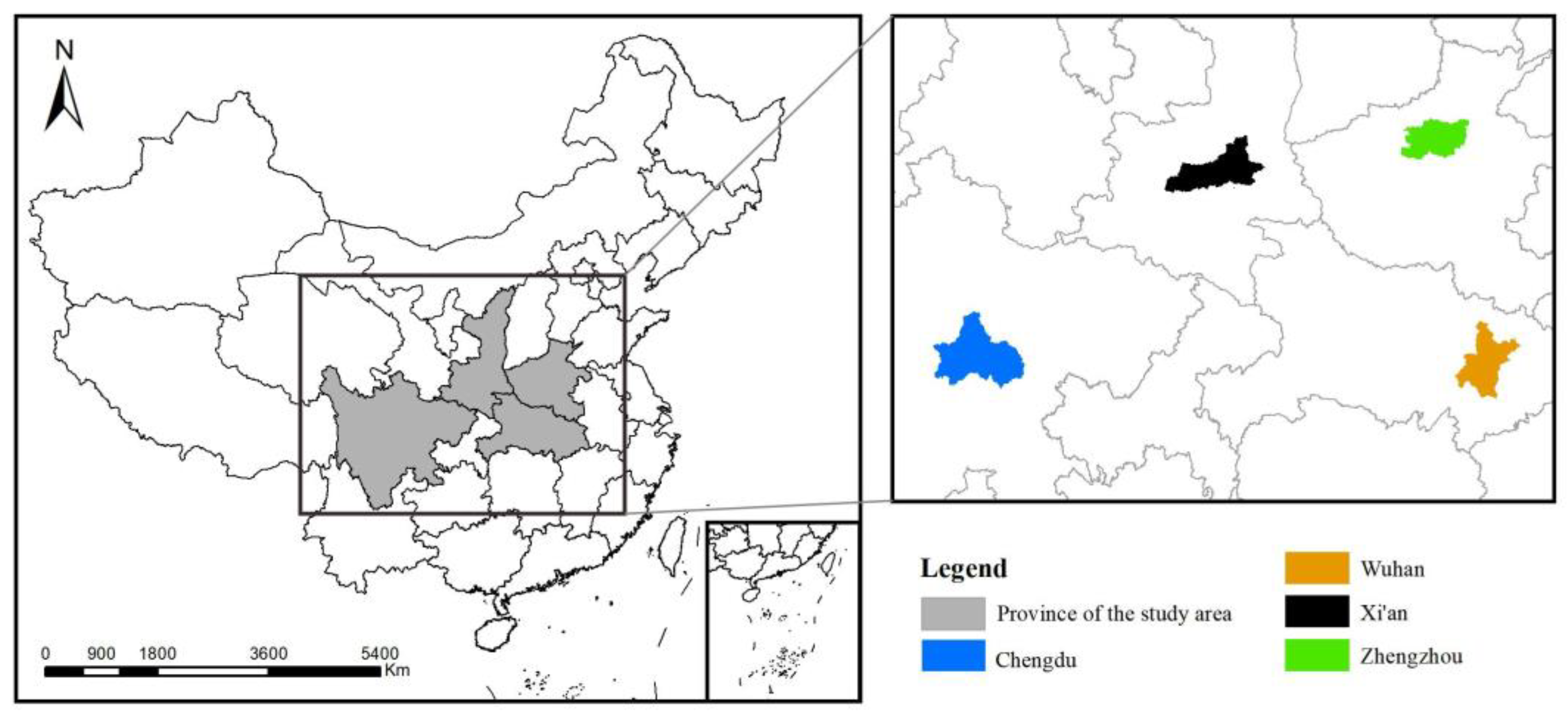

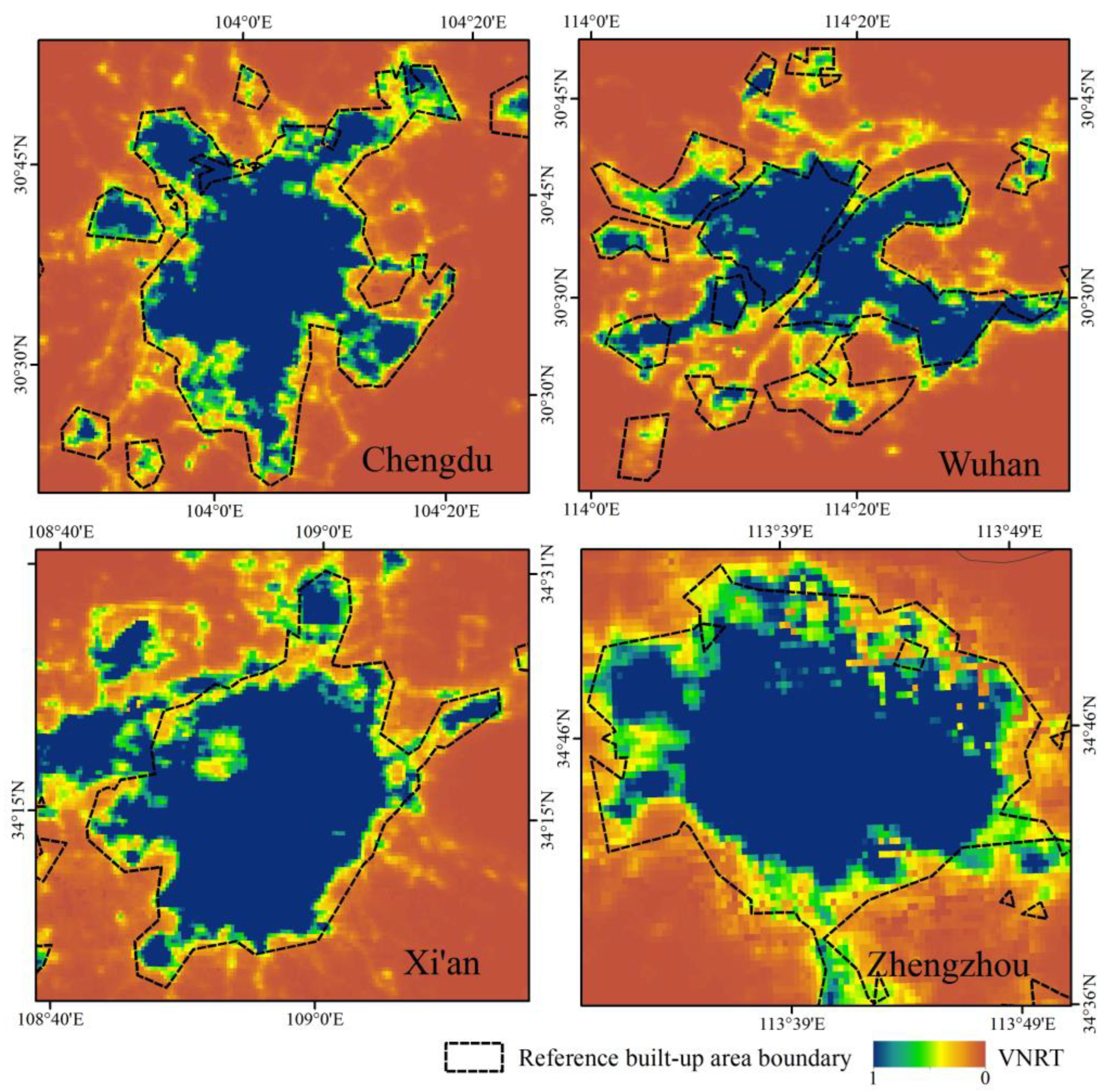
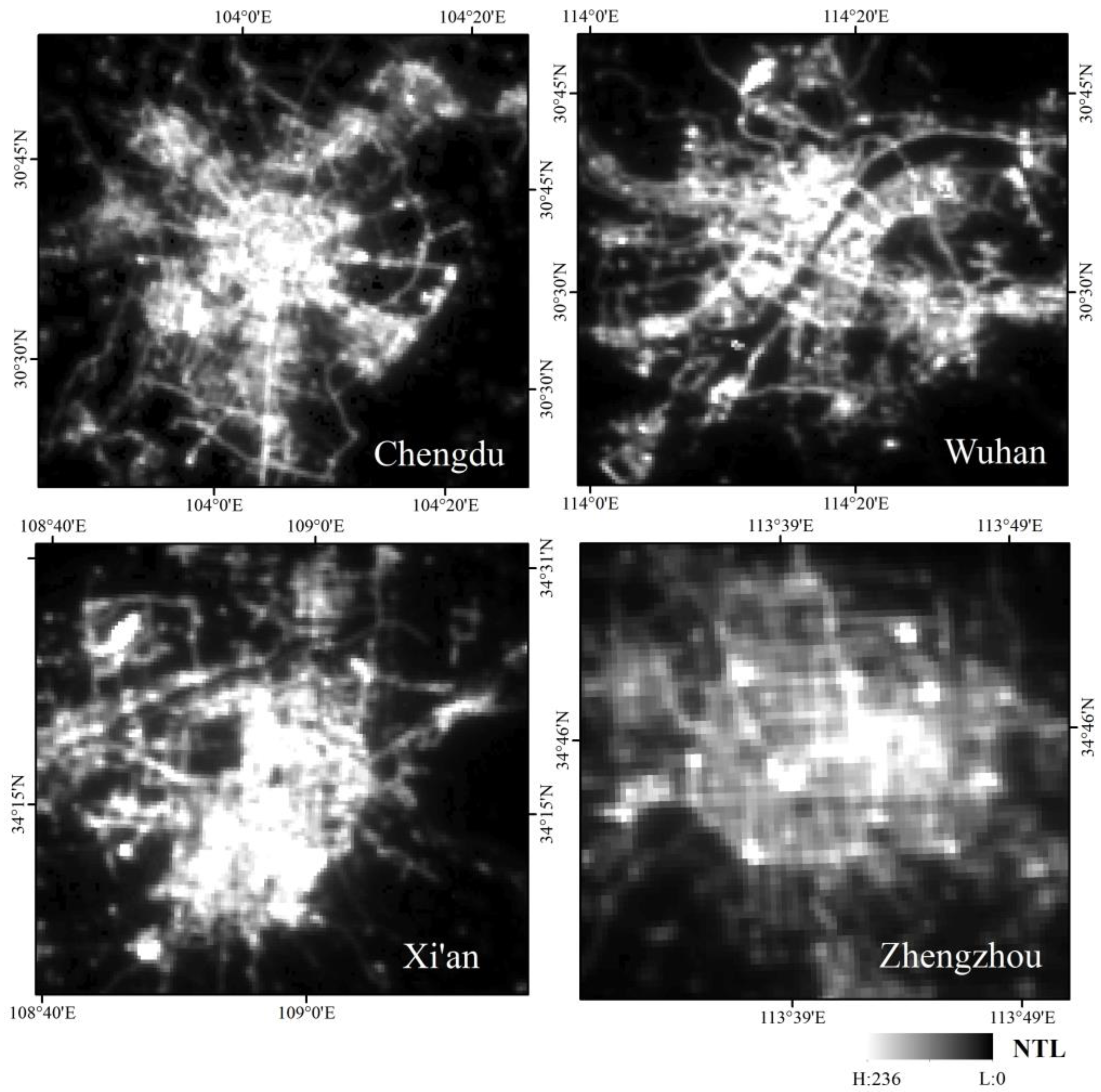
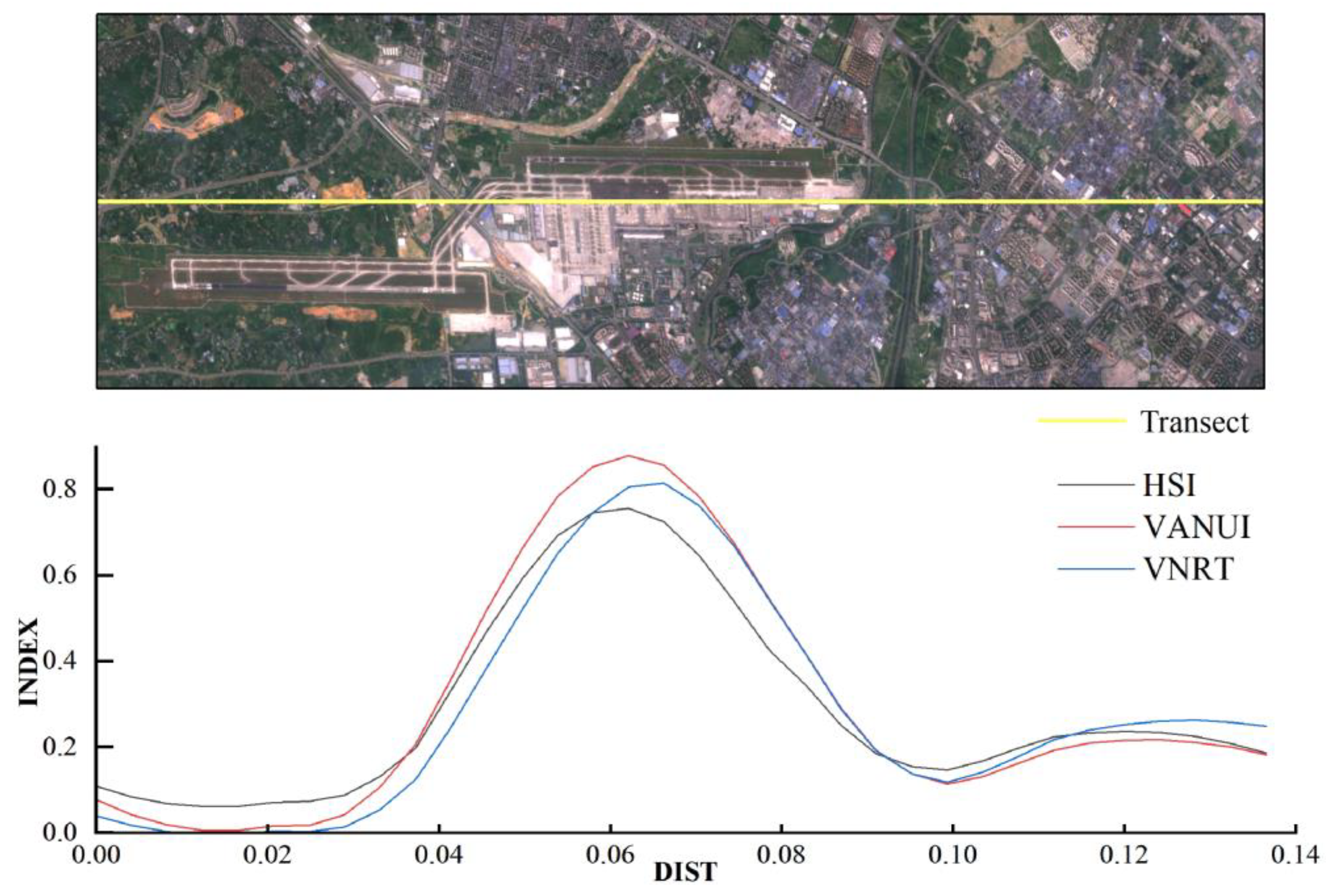

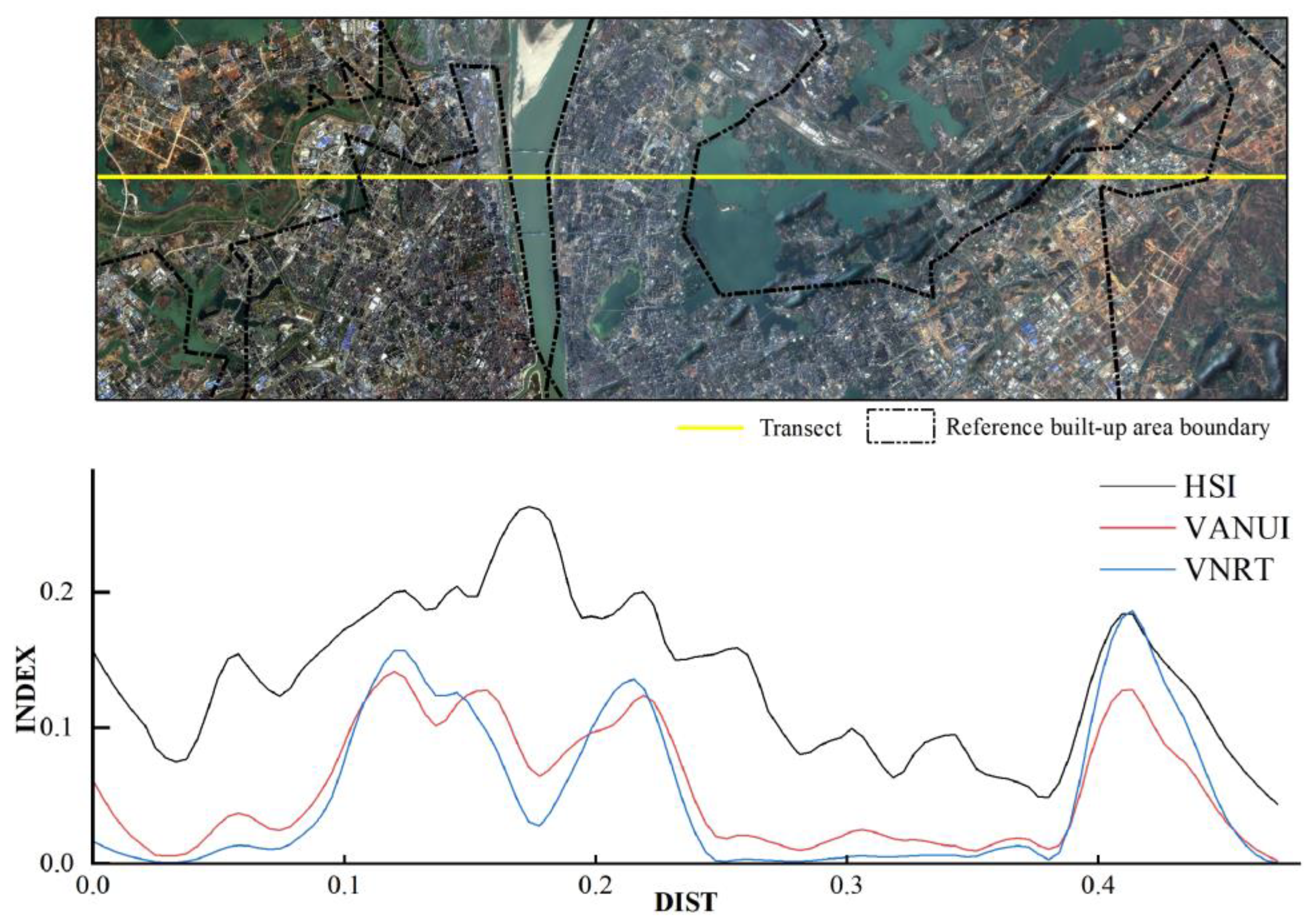
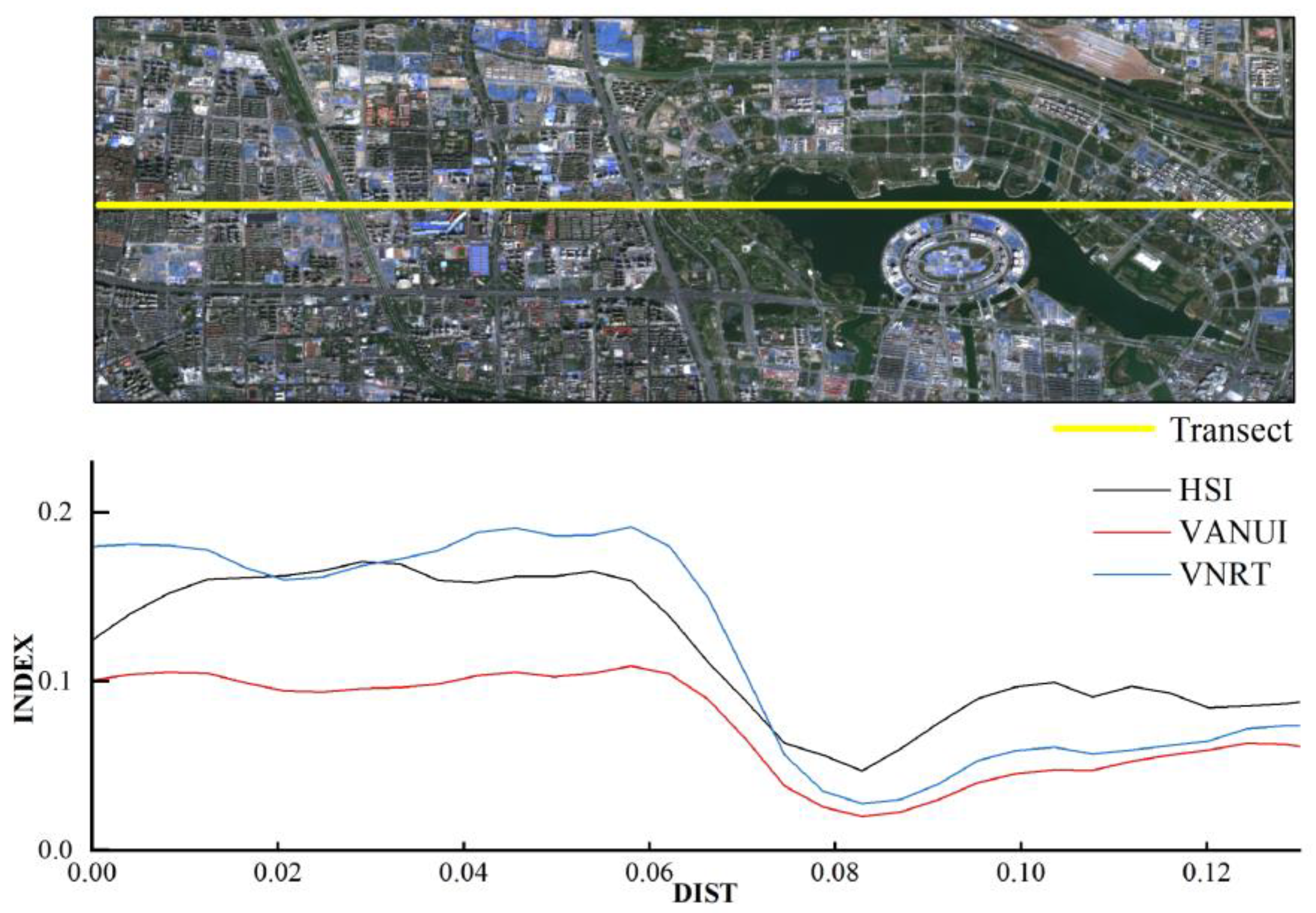
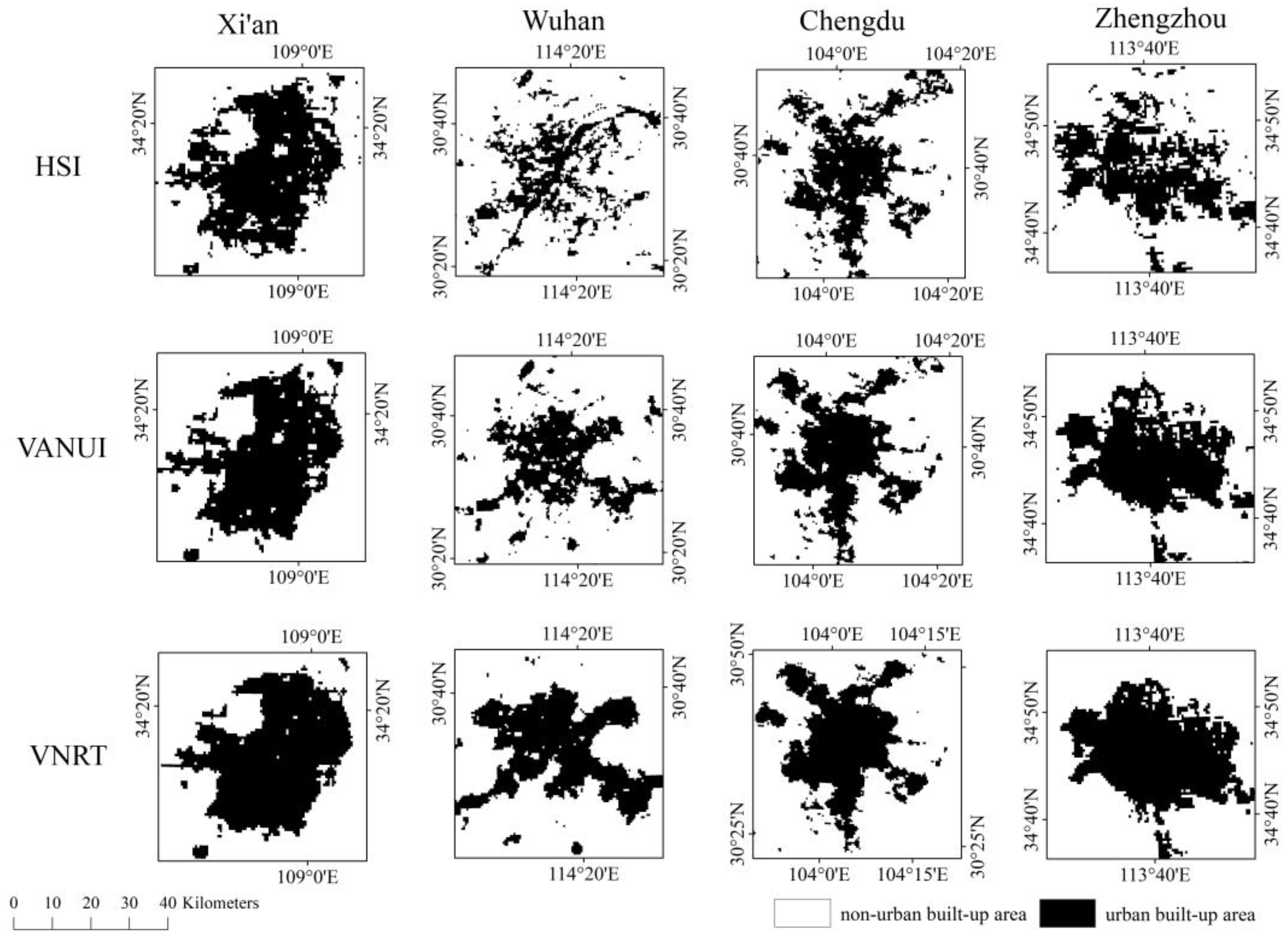
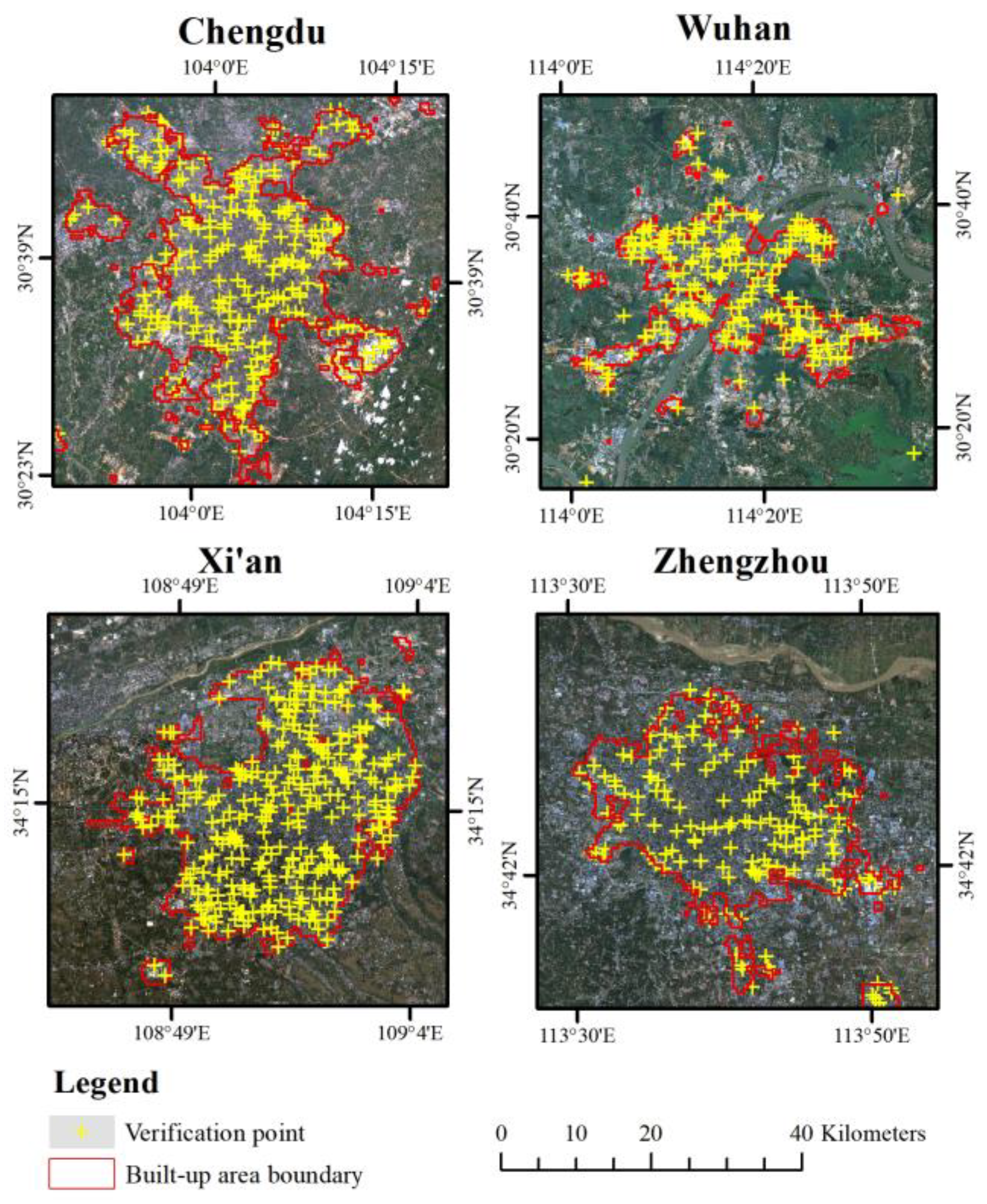
| City | Statistical Data (km2) | Extraction Threshold (q) | ||
|---|---|---|---|---|
| HSI | VANUI | VNRT | ||
| Chengdu | 1111.59 | 0.14 | 0.09 | 0.05 |
| Wuhan | 812.39 | 0.18 | 0.06 | 0.06 |
| Xi’an | 700.69 | 0.14 | 0.11 | 0.07 |
| Zhengzhou | 750.86 | 0.12 | 0.05 | 0.05 |
| City | Index | Accuracy | F1-Score | Kappa | OA (%) |
|---|---|---|---|---|---|
| Chengdu | HSI | 0.89 | 0.80 | 0.66 | 85.70 |
| VANUI | 0.93 | 0.87 | 0.76 | 90.02 | |
| VNRT | 0.97 | 0.95 | 0.86 | 94.24 | |
| Wuhan | HSI | 0.79 | 0.48 | 0.42 | 74.26 |
| VANUI | 0.91 | 0.78 | 0.63 | 86.67 | |
| VNRT | 0.96 | 0.89 | 0.75 | 90.95 | |
| Xi’an | HSI | 0.90 | 0.86 | 0.72 | 86.97 |
| VANUI | 0.93 | 0.89 | 0.78 | 86.41 | |
| VNRT | 0.97 | 0.96 | 0.87 | 93.96 | |
| Zhengzhou | HSI | 0.88 | 0.70 | 0.45 | 78.24 |
| VANUI | 0.94 | 0.84 | 0.60 | 84.35 | |
| VNRT | 0.98 | 0.94 | 0.70 | 88.29 |
Disclaimer/Publisher’s Note: The statements, opinions and data contained in all publications are solely those of the individual author(s) and contributor(s) and not of MDPI and/or the editor(s). MDPI and/or the editor(s) disclaim responsibility for any injury to people or property resulting from any ideas, methods, instructions or products referred to in the content. |
© 2024 by the authors. Licensee MDPI, Basel, Switzerland. This article is an open access article distributed under the terms and conditions of the Creative Commons Attribution (CC BY) license (https://creativecommons.org/licenses/by/4.0/).
Share and Cite
Wang, L.; Chen, S.; Chen, L.; Wang, Z.; Liu, B.; Xu, Y. A New Urban Built-Up Index and Its Application in National Central Cities of China. ISPRS Int. J. Geo-Inf. 2024, 13, 21. https://doi.org/10.3390/ijgi13010021
Wang L, Chen S, Chen L, Wang Z, Liu B, Xu Y. A New Urban Built-Up Index and Its Application in National Central Cities of China. ISPRS International Journal of Geo-Information. 2024; 13(1):21. https://doi.org/10.3390/ijgi13010021
Chicago/Turabian StyleWang, Linfeng, Shengbo Chen, Lei Chen, Zibo Wang, Bin Liu, and Yucheng Xu. 2024. "A New Urban Built-Up Index and Its Application in National Central Cities of China" ISPRS International Journal of Geo-Information 13, no. 1: 21. https://doi.org/10.3390/ijgi13010021
APA StyleWang, L., Chen, S., Chen, L., Wang, Z., Liu, B., & Xu, Y. (2024). A New Urban Built-Up Index and Its Application in National Central Cities of China. ISPRS International Journal of Geo-Information, 13(1), 21. https://doi.org/10.3390/ijgi13010021








